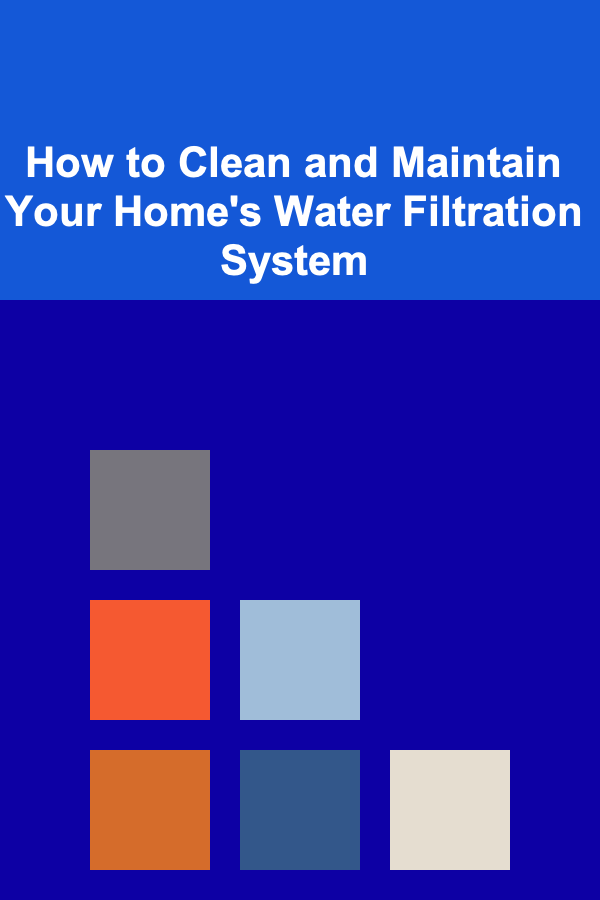
How to Clean and Maintain Your Home's Water Filtration System
ebook include PDF & Audio bundle (Micro Guide)
$12.99$8.99
Limited Time Offer! Order within the next:

Water filtration systems are crucial for ensuring the water we consume is clean, safe, and free from contaminants. Whether you have a simple water filter attached to your faucet or a more complex whole-house water filtration system, regular maintenance is essential to ensure they work efficiently and continue providing safe drinking water. Over time, filters and other components can become clogged, reduce performance, or wear out, which can lead to water quality issues or system failures.
In this article, we will explore how to clean and maintain your home's water filtration system, covering various types of systems, maintenance schedules, cleaning procedures, and tips to extend the lifespan of your filtration setup.
Types of Water Filtration Systems
Before diving into the specifics of cleaning and maintenance, it's important to understand the various types of water filtration systems commonly used in homes. Each type has different components that require attention and care.
1. Faucet-mounted filters
These are small filters that attach directly to your faucet and are used to filter drinking water. They are usually simple to install and maintain, but they need frequent cartridge changes to maintain performance.
2. Under-sink filters
Under-sink filters are installed beneath the sink, where they filter water before it reaches your faucet. These systems typically consist of several stages, such as activated carbon filters, reverse osmosis membranes, and sediment filters.
3. Whole-house filtration systems
A whole-house system is installed at the point where the water enters your home and filters all of the water that comes through your pipes. These systems can include sediment filters, activated carbon filters, water softeners, and more complex filtration methods like reverse osmosis.
4. Reverse osmosis (RO) systems
Reverse osmosis systems are one of the most thorough water filtration methods, using a semipermeable membrane to remove contaminants. These systems are usually installed under the sink and often have multiple stages, including pre-filters and post-filters.
5. Pitcher filters
Water filter pitchers are portable and easy to use, with activated carbon and sometimes ion exchange resins to filter tap water. They need regular refilling and occasional cleaning but are less expensive than other filtration methods.
Why Cleaning and Maintenance Matter
Proper maintenance of your water filtration system is necessary for several reasons:
1. Efficiency
A clogged or dirty filter can reduce water flow, making it harder to access clean water. Regular maintenance ensures that your system operates efficiently.
2. Water Quality
Filters are designed to remove contaminants such as chlorine, lead, sediment, and bacteria. Over time, these filters lose their effectiveness as they become saturated. Cleaning and replacing filters as needed will ensure that your water stays safe and clean.
3. Longevity
Water filtration systems, like all appliances, can wear out if not properly maintained. Regular cleaning and replacing parts can extend the lifespan of your filtration system and prevent costly repairs or replacements.
4. Preventing Mold and Bacteria Growth
If filters or components of the system are not cleaned regularly, bacteria, mold, and algae can start to grow. This could compromise the quality of your drinking water and potentially lead to health issues.
General Guidelines for Cleaning and Maintaining Water Filtration Systems
No matter what type of water filtration system you have, there are general guidelines for maintaining it. Below, we will cover basic steps to clean and maintain your system, including when to replace parts, how to clean different components, and signs that your system might need attention.
1. Turn off the Water Supply
Before starting any maintenance on your water filtration system, turn off the water supply to the unit. This will prevent water from flowing while you're cleaning or replacing parts and reduce the chance of leaks or accidents.
2. Check Manufacturer's Instructions
Different water filtration systems have specific maintenance requirements. Always refer to the manufacturer's guidelines for cleaning and maintenance schedules. These instructions will provide the most accurate and relevant information for your system.
3. Regular Filter Replacement
Most filters, whether in a faucet filter, under-sink system, or whole-house filter, need to be replaced periodically. The frequency of filter replacement depends on the type of filter and the volume of water used in your home. For example:
- Activated carbon filters typically need replacing every 3 to 6 months.
- Reverse osmosis membranes need replacement every 2 to 3 years.
- Sediment filters may need replacing more frequently, depending on the water quality and use.
How to Replace Filters:
- Turn off the water supply.
- Remove the filter by unscrewing or pulling it out, depending on your system type.
- Insert the new filter, ensuring it is properly aligned and securely fastened.
- Turn the water supply back on and check for leaks.
4. Cleaning and Disinfecting the System
Even though filters need to be replaced, other components of your water filtration system require cleaning to prevent mold, bacteria, and buildup of contaminants.
Faucet-mounted Filters:
- Detach the filter from the faucet.
- Soak it in a vinegar and water solution (about 50% vinegar, 50% water) for 30 minutes to remove mineral buildup.
- Use a soft brush to scrub away any remaining debris.
- Rinse thoroughly before reattaching.
Under-sink and Whole-house Filters:
- If the system has any pre-filters or sediment filters, remove them and rinse under cold water to remove debris.
- Use a disinfecting solution to clean the housing of the filters. Ensure the solution is safe and doesn't leave harmful residues.
- Clean any hoses or connectors with a mixture of vinegar and water to remove calcium or lime deposits.
- Be sure to follow the manufacturer's instructions for disinfecting the system.
Reverse Osmosis Systems:
- Disassemble the system as instructed by the manufacturer.
- Clean the pre-filters and membranes by gently rinsing them with a water-vinegar solution. Be careful not to damage the RO membrane.
- Clean the tank and other parts with an appropriate disinfectant.
- Rinse thoroughly before reassembling.
5. Check for Leaks and Damage
Inspect all the connections, hoses, and components of your filtration system regularly for signs of wear and leaks. If you find any damaged parts, replace them immediately to avoid water damage or contamination.
6. Monitor Water Pressure
If you notice a decrease in water pressure from your filtration system, it could be a sign of clogged filters or a build-up of sediment. Check the filters and replace them if necessary. Low pressure can also be caused by leaks or air in the system, so it's important to troubleshoot the issue thoroughly.
7. Maintain the Entire Plumbing System
Water filtration systems are only one part of your home's water system. It's essential to maintain the plumbing, including pipes and faucets, to ensure your filtration system operates efficiently. For example, check for leaks in pipes that could lead to contamination or reduced water pressure.
How Often Should You Clean and Replace Filters?
To keep your filtration system in top condition, regular cleaning and filter replacement are necessary. Here's a general guide for how often to perform these tasks:
1. Faucet-mounted filters
- Replace filters every 2 to 3 months or when the water flow slows down.
- Clean the filter housing every month.
2. Under-sink filters
- Replace filters every 6 to 12 months, depending on water quality and usage.
- Clean the system every 6 months.
3. Whole-house filters
- Replace pre-filters every 3 to 6 months.
- Change the main filters annually.
- Clean the entire system once a year.
4. Reverse osmosis systems
- Replace the RO membrane every 2 to 3 years.
- Change pre-filters every 6 to 12 months.
- Clean the system every 6 months.
Troubleshooting Common Problems
Despite regular maintenance, you may encounter problems with your water filtration system. Some common issues and their solutions include:
1. Water Flow is Slow
This is usually due to clogged filters. If you notice a decrease in water flow, check and replace the filters. Cleaning the system can also help alleviate this issue.
2. Water Tastes or Smells Bad
If your water starts to taste or smell unpleasant, it might be due to old or clogged filters. Replace the filters and disinfect the system to ensure that contaminants are removed.
3. Leaks
Leaks around the system could be a result of loose connections, cracked hoses, or worn-out seals. Tighten connections and replace any damaged parts.
4. Cloudy or Murky Water
Cloudy water may indicate an issue with the filtration process or contamination in the system. It's important to clean the filters and the system to prevent this problem.
Conclusion
Maintaining your water filtration system is essential for ensuring the quality and safety of your drinking water. By following a regular cleaning and maintenance schedule, replacing filters when needed, and keeping an eye out for any signs of trouble, you can help extend the lifespan of your system and ensure that your water remains clean and safe for consumption.

How to Make a Statement with DIY Wall Art
Read More
Turning Your Deep Learning Knowledge into a Profitable Venture
Read More
How to Manage Oily Skin and Control Shine
Read More
How to Identify Hidden Singles in Sudoku
Read More
How to Build and Lead a High-Performing IT Team
Read More10 Tips for Tracking Progress on Your Social Media To-Do List
Read MoreOther Products

How to Make a Statement with DIY Wall Art
Read More
Turning Your Deep Learning Knowledge into a Profitable Venture
Read More
How to Manage Oily Skin and Control Shine
Read More
How to Identify Hidden Singles in Sudoku
Read More